Project Leadership Report: Analysis of Leadership Styles and Ranking
VerifiedAdded on 2023/01/23
|25
|7229
|83
Report
AI Summary
This report provides a comprehensive analysis of project leadership, exploring various leadership styles such as autocratic, transactional, democratic, transformational, and coaching leadership. It begins by examining the leadership skills of individual team members, assigning each a specific leadership model based on their personality traits and characteristics. The report then delves into a case study of five companies, evaluating their project leadership styles and ranking them based on criteria like team structure, communication, and leader effectiveness. The ranking criteria are aligned with project leadership theory and practical project management, assessing how different leadership styles impact project outcomes. The report also includes a detailed ranking of the team members and stakeholders. The conclusion offers recommendations for effective project leadership, emphasizing the importance of selecting the right leadership style for different project phases. The document concludes with a reference list.

Project Leadership
1
1
Paraphrase This Document
Need a fresh take? Get an instant paraphrase of this document with our AI Paraphraser
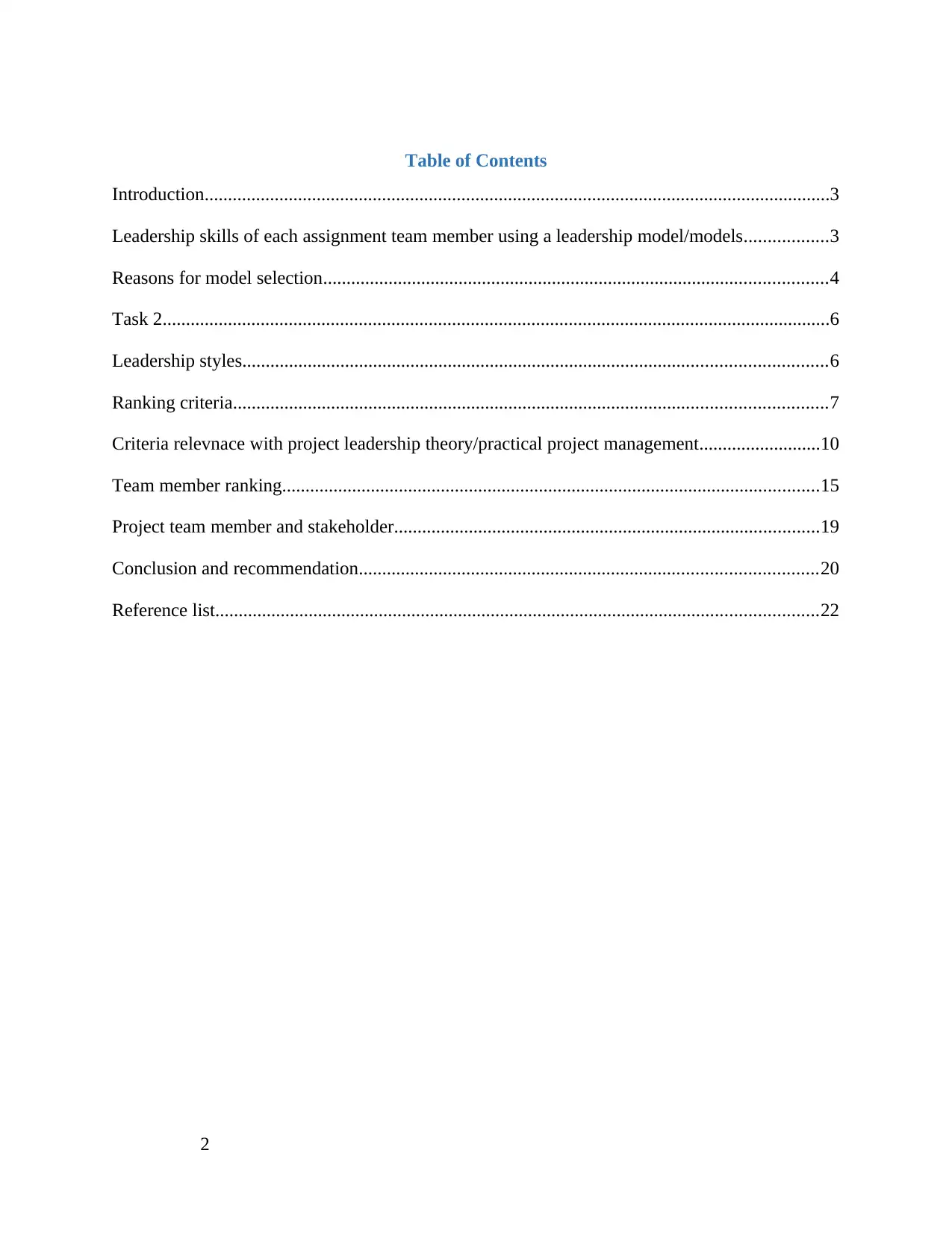
Table of Contents
Introduction......................................................................................................................................3
Leadership skills of each assignment team member using a leadership model/models..................3
Reasons for model selection............................................................................................................4
Task 2...............................................................................................................................................6
Leadership styles.............................................................................................................................6
Ranking criteria...............................................................................................................................7
Criteria relevnace with project leadership theory/practical project management..........................10
Team member ranking...................................................................................................................15
Project team member and stakeholder...........................................................................................19
Conclusion and recommendation..................................................................................................20
Reference list.................................................................................................................................22
2
Introduction......................................................................................................................................3
Leadership skills of each assignment team member using a leadership model/models..................3
Reasons for model selection............................................................................................................4
Task 2...............................................................................................................................................6
Leadership styles.............................................................................................................................6
Ranking criteria...............................................................................................................................7
Criteria relevnace with project leadership theory/practical project management..........................10
Team member ranking...................................................................................................................15
Project team member and stakeholder...........................................................................................19
Conclusion and recommendation..................................................................................................20
Reference list.................................................................................................................................22
2
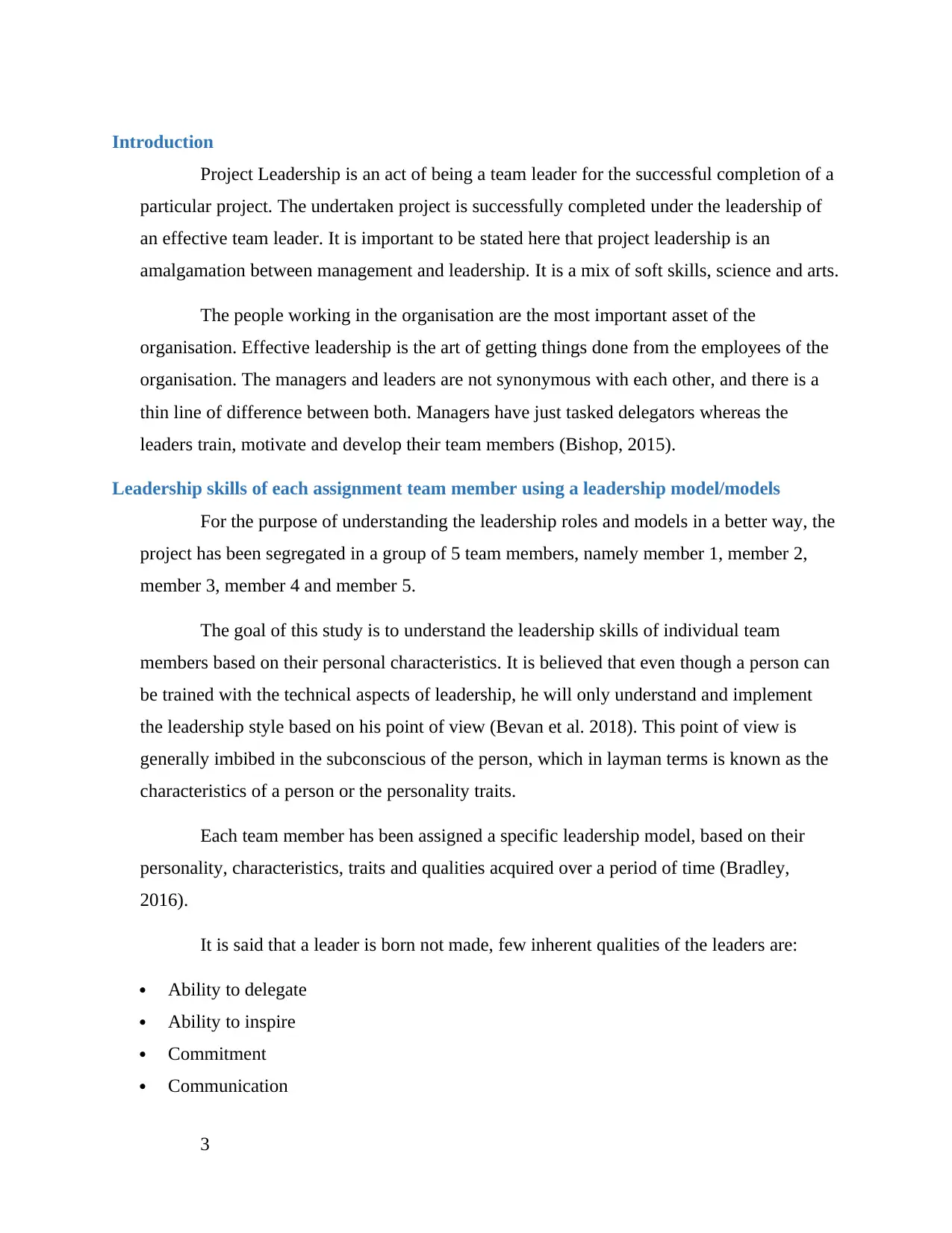
Introduction
Project Leadership is an act of being a team leader for the successful completion of a
particular project. The undertaken project is successfully completed under the leadership of
an effective team leader. It is important to be stated here that project leadership is an
amalgamation between management and leadership. It is a mix of soft skills, science and arts.
The people working in the organisation are the most important asset of the
organisation. Effective leadership is the art of getting things done from the employees of the
organisation. The managers and leaders are not synonymous with each other, and there is a
thin line of difference between both. Managers have just tasked delegators whereas the
leaders train, motivate and develop their team members (Bishop, 2015).
Leadership skills of each assignment team member using a leadership model/models
For the purpose of understanding the leadership roles and models in a better way, the
project has been segregated in a group of 5 team members, namely member 1, member 2,
member 3, member 4 and member 5.
The goal of this study is to understand the leadership skills of individual team
members based on their personal characteristics. It is believed that even though a person can
be trained with the technical aspects of leadership, he will only understand and implement
the leadership style based on his point of view (Bevan et al. 2018). This point of view is
generally imbibed in the subconscious of the person, which in layman terms is known as the
characteristics of a person or the personality traits.
Each team member has been assigned a specific leadership model, based on their
personality, characteristics, traits and qualities acquired over a period of time (Bradley,
2016).
It is said that a leader is born not made, few inherent qualities of the leaders are:
Ability to delegate
Ability to inspire
Commitment
Communication
3
Project Leadership is an act of being a team leader for the successful completion of a
particular project. The undertaken project is successfully completed under the leadership of
an effective team leader. It is important to be stated here that project leadership is an
amalgamation between management and leadership. It is a mix of soft skills, science and arts.
The people working in the organisation are the most important asset of the
organisation. Effective leadership is the art of getting things done from the employees of the
organisation. The managers and leaders are not synonymous with each other, and there is a
thin line of difference between both. Managers have just tasked delegators whereas the
leaders train, motivate and develop their team members (Bishop, 2015).
Leadership skills of each assignment team member using a leadership model/models
For the purpose of understanding the leadership roles and models in a better way, the
project has been segregated in a group of 5 team members, namely member 1, member 2,
member 3, member 4 and member 5.
The goal of this study is to understand the leadership skills of individual team
members based on their personal characteristics. It is believed that even though a person can
be trained with the technical aspects of leadership, he will only understand and implement
the leadership style based on his point of view (Bevan et al. 2018). This point of view is
generally imbibed in the subconscious of the person, which in layman terms is known as the
characteristics of a person or the personality traits.
Each team member has been assigned a specific leadership model, based on their
personality, characteristics, traits and qualities acquired over a period of time (Bradley,
2016).
It is said that a leader is born not made, few inherent qualities of the leaders are:
Ability to delegate
Ability to inspire
Commitment
Communication
3
⊘ This is a preview!⊘
Do you want full access?
Subscribe today to unlock all pages.

Trusted by 1+ million students worldwide
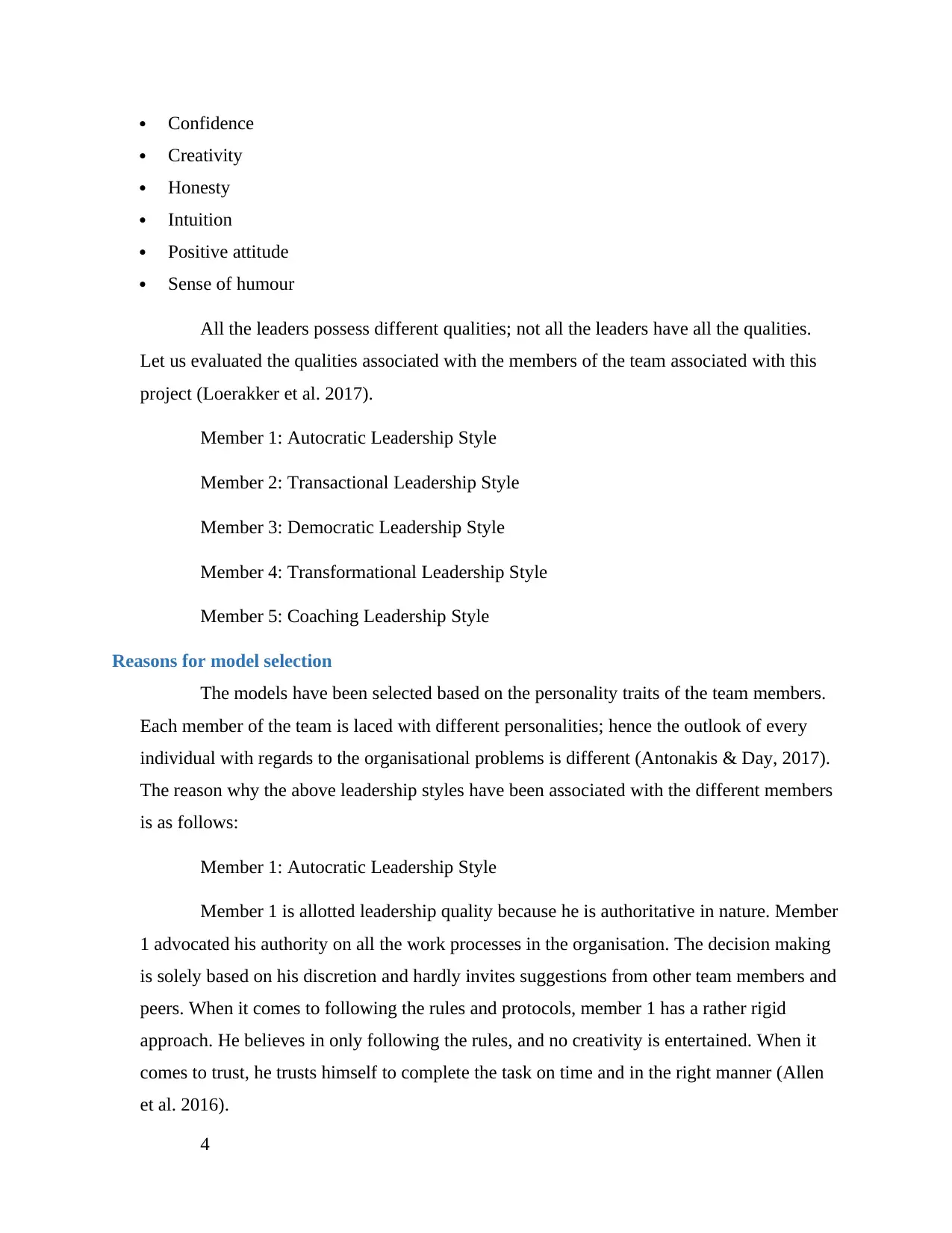
Confidence
Creativity
Honesty
Intuition
Positive attitude
Sense of humour
All the leaders possess different qualities; not all the leaders have all the qualities.
Let us evaluated the qualities associated with the members of the team associated with this
project (Loerakker et al. 2017).
Member 1: Autocratic Leadership Style
Member 2: Transactional Leadership Style
Member 3: Democratic Leadership Style
Member 4: Transformational Leadership Style
Member 5: Coaching Leadership Style
Reasons for model selection
The models have been selected based on the personality traits of the team members.
Each member of the team is laced with different personalities; hence the outlook of every
individual with regards to the organisational problems is different (Antonakis & Day, 2017).
The reason why the above leadership styles have been associated with the different members
is as follows:
Member 1: Autocratic Leadership Style
Member 1 is allotted leadership quality because he is authoritative in nature. Member
1 advocated his authority on all the work processes in the organisation. The decision making
is solely based on his discretion and hardly invites suggestions from other team members and
peers. When it comes to following the rules and protocols, member 1 has a rather rigid
approach. He believes in only following the rules, and no creativity is entertained. When it
comes to trust, he trusts himself to complete the task on time and in the right manner (Allen
et al. 2016).
4
Creativity
Honesty
Intuition
Positive attitude
Sense of humour
All the leaders possess different qualities; not all the leaders have all the qualities.
Let us evaluated the qualities associated with the members of the team associated with this
project (Loerakker et al. 2017).
Member 1: Autocratic Leadership Style
Member 2: Transactional Leadership Style
Member 3: Democratic Leadership Style
Member 4: Transformational Leadership Style
Member 5: Coaching Leadership Style
Reasons for model selection
The models have been selected based on the personality traits of the team members.
Each member of the team is laced with different personalities; hence the outlook of every
individual with regards to the organisational problems is different (Antonakis & Day, 2017).
The reason why the above leadership styles have been associated with the different members
is as follows:
Member 1: Autocratic Leadership Style
Member 1 is allotted leadership quality because he is authoritative in nature. Member
1 advocated his authority on all the work processes in the organisation. The decision making
is solely based on his discretion and hardly invites suggestions from other team members and
peers. When it comes to following the rules and protocols, member 1 has a rather rigid
approach. He believes in only following the rules, and no creativity is entertained. When it
comes to trust, he trusts himself to complete the task on time and in the right manner (Allen
et al. 2016).
4
Paraphrase This Document
Need a fresh take? Get an instant paraphrase of this document with our AI Paraphraser
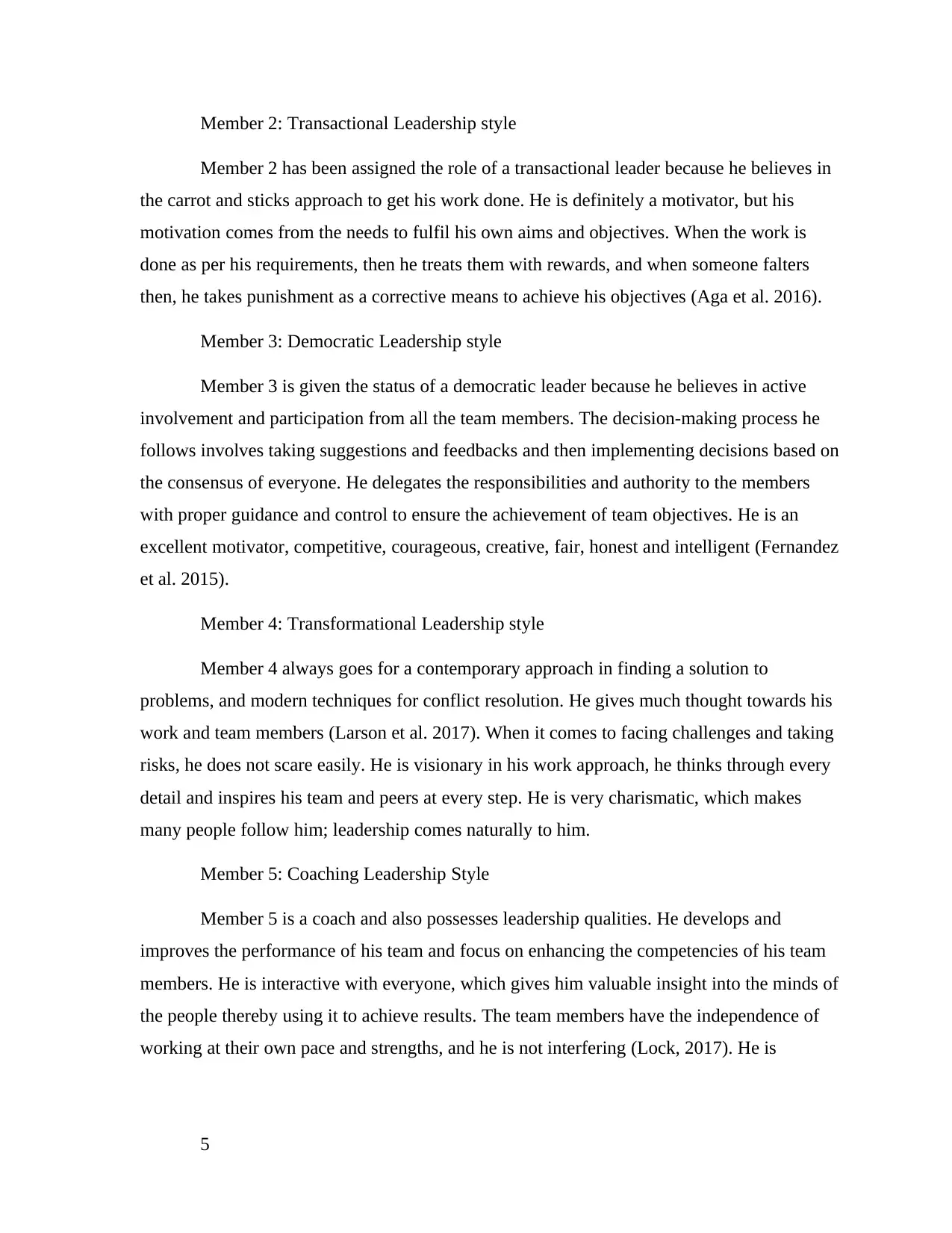
Member 2: Transactional Leadership style
Member 2 has been assigned the role of a transactional leader because he believes in
the carrot and sticks approach to get his work done. He is definitely a motivator, but his
motivation comes from the needs to fulfil his own aims and objectives. When the work is
done as per his requirements, then he treats them with rewards, and when someone falters
then, he takes punishment as a corrective means to achieve his objectives (Aga et al. 2016).
Member 3: Democratic Leadership style
Member 3 is given the status of a democratic leader because he believes in active
involvement and participation from all the team members. The decision-making process he
follows involves taking suggestions and feedbacks and then implementing decisions based on
the consensus of everyone. He delegates the responsibilities and authority to the members
with proper guidance and control to ensure the achievement of team objectives. He is an
excellent motivator, competitive, courageous, creative, fair, honest and intelligent (Fernandez
et al. 2015).
Member 4: Transformational Leadership style
Member 4 always goes for a contemporary approach in finding a solution to
problems, and modern techniques for conflict resolution. He gives much thought towards his
work and team members (Larson et al. 2017). When it comes to facing challenges and taking
risks, he does not scare easily. He is visionary in his work approach, he thinks through every
detail and inspires his team and peers at every step. He is very charismatic, which makes
many people follow him; leadership comes naturally to him.
Member 5: Coaching Leadership Style
Member 5 is a coach and also possesses leadership qualities. He develops and
improves the performance of his team and focus on enhancing the competencies of his team
members. He is interactive with everyone, which gives him valuable insight into the minds of
the people thereby using it to achieve results. The team members have the independence of
working at their own pace and strengths, and he is not interfering (Lock, 2017). He is
5
Member 2 has been assigned the role of a transactional leader because he believes in
the carrot and sticks approach to get his work done. He is definitely a motivator, but his
motivation comes from the needs to fulfil his own aims and objectives. When the work is
done as per his requirements, then he treats them with rewards, and when someone falters
then, he takes punishment as a corrective means to achieve his objectives (Aga et al. 2016).
Member 3: Democratic Leadership style
Member 3 is given the status of a democratic leader because he believes in active
involvement and participation from all the team members. The decision-making process he
follows involves taking suggestions and feedbacks and then implementing decisions based on
the consensus of everyone. He delegates the responsibilities and authority to the members
with proper guidance and control to ensure the achievement of team objectives. He is an
excellent motivator, competitive, courageous, creative, fair, honest and intelligent (Fernandez
et al. 2015).
Member 4: Transformational Leadership style
Member 4 always goes for a contemporary approach in finding a solution to
problems, and modern techniques for conflict resolution. He gives much thought towards his
work and team members (Larson et al. 2017). When it comes to facing challenges and taking
risks, he does not scare easily. He is visionary in his work approach, he thinks through every
detail and inspires his team and peers at every step. He is very charismatic, which makes
many people follow him; leadership comes naturally to him.
Member 5: Coaching Leadership Style
Member 5 is a coach and also possesses leadership qualities. He develops and
improves the performance of his team and focus on enhancing the competencies of his team
members. He is interactive with everyone, which gives him valuable insight into the minds of
the people thereby using it to achieve results. The team members have the independence of
working at their own pace and strengths, and he is not interfering (Lock, 2017). He is
5
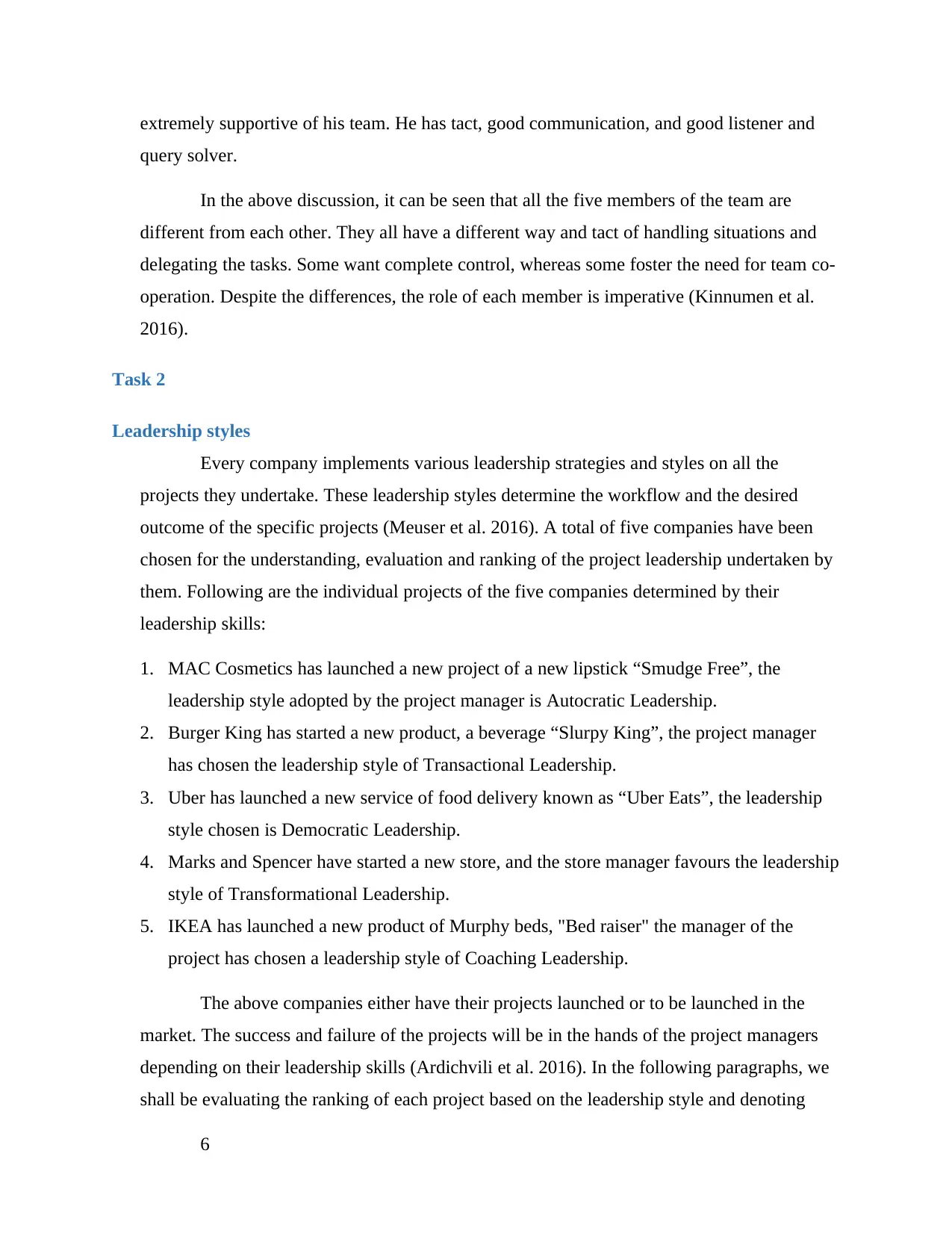
extremely supportive of his team. He has tact, good communication, and good listener and
query solver.
In the above discussion, it can be seen that all the five members of the team are
different from each other. They all have a different way and tact of handling situations and
delegating the tasks. Some want complete control, whereas some foster the need for team co-
operation. Despite the differences, the role of each member is imperative (Kinnumen et al.
2016).
Task 2
Leadership styles
Every company implements various leadership strategies and styles on all the
projects they undertake. These leadership styles determine the workflow and the desired
outcome of the specific projects (Meuser et al. 2016). A total of five companies have been
chosen for the understanding, evaluation and ranking of the project leadership undertaken by
them. Following are the individual projects of the five companies determined by their
leadership skills:
1. MAC Cosmetics has launched a new project of a new lipstick “Smudge Free”, the
leadership style adopted by the project manager is Autocratic Leadership.
2. Burger King has started a new product, a beverage “Slurpy King”, the project manager
has chosen the leadership style of Transactional Leadership.
3. Uber has launched a new service of food delivery known as “Uber Eats”, the leadership
style chosen is Democratic Leadership.
4. Marks and Spencer have started a new store, and the store manager favours the leadership
style of Transformational Leadership.
5. IKEA has launched a new product of Murphy beds, "Bed raiser" the manager of the
project has chosen a leadership style of Coaching Leadership.
The above companies either have their projects launched or to be launched in the
market. The success and failure of the projects will be in the hands of the project managers
depending on their leadership skills (Ardichvili et al. 2016). In the following paragraphs, we
shall be evaluating the ranking of each project based on the leadership style and denoting
6
query solver.
In the above discussion, it can be seen that all the five members of the team are
different from each other. They all have a different way and tact of handling situations and
delegating the tasks. Some want complete control, whereas some foster the need for team co-
operation. Despite the differences, the role of each member is imperative (Kinnumen et al.
2016).
Task 2
Leadership styles
Every company implements various leadership strategies and styles on all the
projects they undertake. These leadership styles determine the workflow and the desired
outcome of the specific projects (Meuser et al. 2016). A total of five companies have been
chosen for the understanding, evaluation and ranking of the project leadership undertaken by
them. Following are the individual projects of the five companies determined by their
leadership skills:
1. MAC Cosmetics has launched a new project of a new lipstick “Smudge Free”, the
leadership style adopted by the project manager is Autocratic Leadership.
2. Burger King has started a new product, a beverage “Slurpy King”, the project manager
has chosen the leadership style of Transactional Leadership.
3. Uber has launched a new service of food delivery known as “Uber Eats”, the leadership
style chosen is Democratic Leadership.
4. Marks and Spencer have started a new store, and the store manager favours the leadership
style of Transformational Leadership.
5. IKEA has launched a new product of Murphy beds, "Bed raiser" the manager of the
project has chosen a leadership style of Coaching Leadership.
The above companies either have their projects launched or to be launched in the
market. The success and failure of the projects will be in the hands of the project managers
depending on their leadership skills (Ardichvili et al. 2016). In the following paragraphs, we
shall be evaluating the ranking of each project based on the leadership style and denoting
6
⊘ This is a preview!⊘
Do you want full access?
Subscribe today to unlock all pages.

Trusted by 1+ million students worldwide
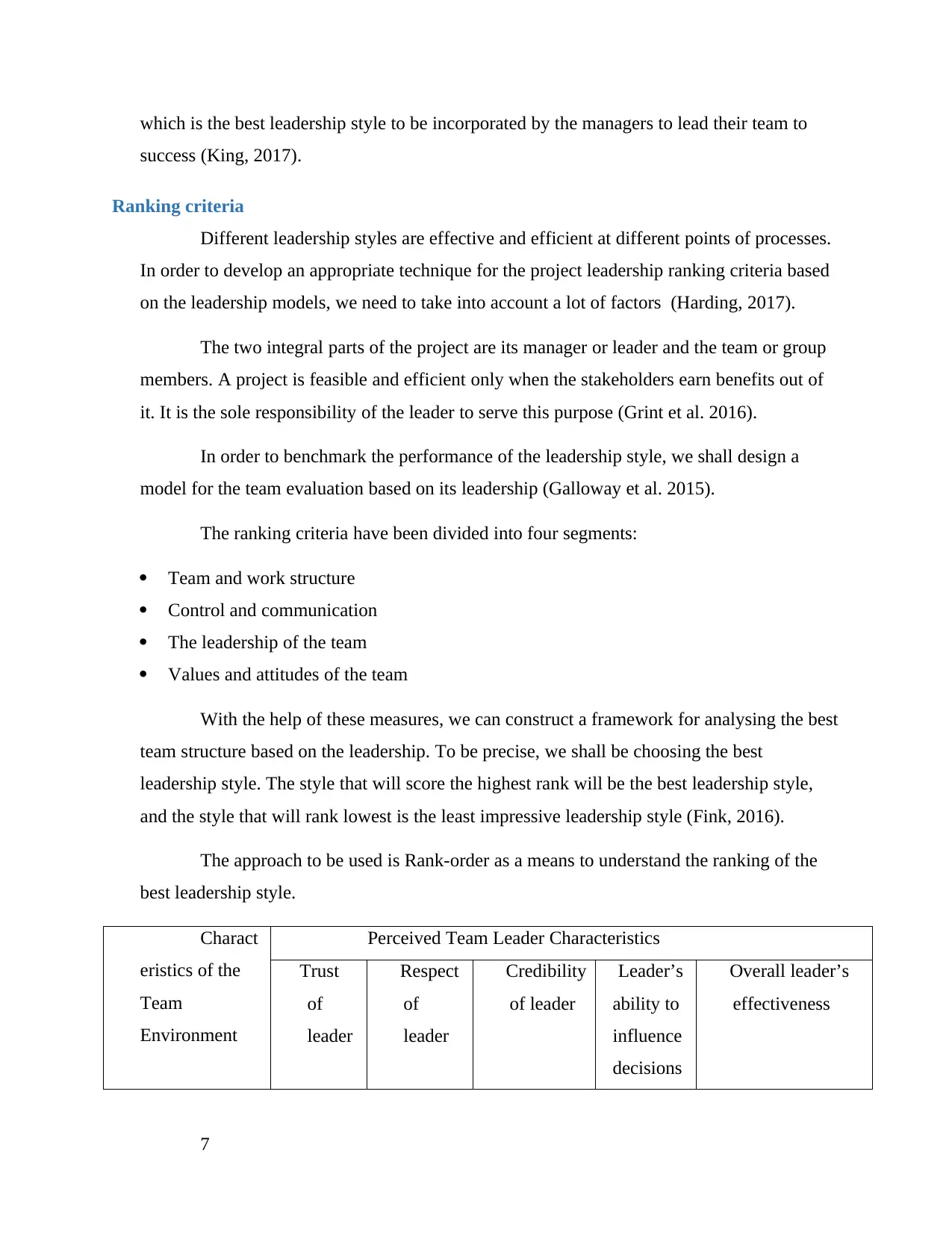
which is the best leadership style to be incorporated by the managers to lead their team to
success (King, 2017).
Ranking criteria
Different leadership styles are effective and efficient at different points of processes.
In order to develop an appropriate technique for the project leadership ranking criteria based
on the leadership models, we need to take into account a lot of factors (Harding, 2017).
The two integral parts of the project are its manager or leader and the team or group
members. A project is feasible and efficient only when the stakeholders earn benefits out of
it. It is the sole responsibility of the leader to serve this purpose (Grint et al. 2016).
In order to benchmark the performance of the leadership style, we shall design a
model for the team evaluation based on its leadership (Galloway et al. 2015).
The ranking criteria have been divided into four segments:
Team and work structure
Control and communication
The leadership of the team
Values and attitudes of the team
With the help of these measures, we can construct a framework for analysing the best
team structure based on the leadership. To be precise, we shall be choosing the best
leadership style. The style that will score the highest rank will be the best leadership style,
and the style that will rank lowest is the least impressive leadership style (Fink, 2016).
The approach to be used is Rank-order as a means to understand the ranking of the
best leadership style.
Charact
eristics of the
Team
Environment
Perceived Team Leader Characteristics
Trust
of
leader
Respect
of
leader
Credibility
of leader
Leader’s
ability to
influence
decisions
Overall leader’s
effectiveness
7
success (King, 2017).
Ranking criteria
Different leadership styles are effective and efficient at different points of processes.
In order to develop an appropriate technique for the project leadership ranking criteria based
on the leadership models, we need to take into account a lot of factors (Harding, 2017).
The two integral parts of the project are its manager or leader and the team or group
members. A project is feasible and efficient only when the stakeholders earn benefits out of
it. It is the sole responsibility of the leader to serve this purpose (Grint et al. 2016).
In order to benchmark the performance of the leadership style, we shall design a
model for the team evaluation based on its leadership (Galloway et al. 2015).
The ranking criteria have been divided into four segments:
Team and work structure
Control and communication
The leadership of the team
Values and attitudes of the team
With the help of these measures, we can construct a framework for analysing the best
team structure based on the leadership. To be precise, we shall be choosing the best
leadership style. The style that will score the highest rank will be the best leadership style,
and the style that will rank lowest is the least impressive leadership style (Fink, 2016).
The approach to be used is Rank-order as a means to understand the ranking of the
best leadership style.
Charact
eristics of the
Team
Environment
Perceived Team Leader Characteristics
Trust
of
leader
Respect
of
leader
Credibility
of leader
Leader’s
ability to
influence
decisions
Overall leader’s
effectiveness
7
Paraphrase This Document
Need a fresh take? Get an instant paraphrase of this document with our AI Paraphraser
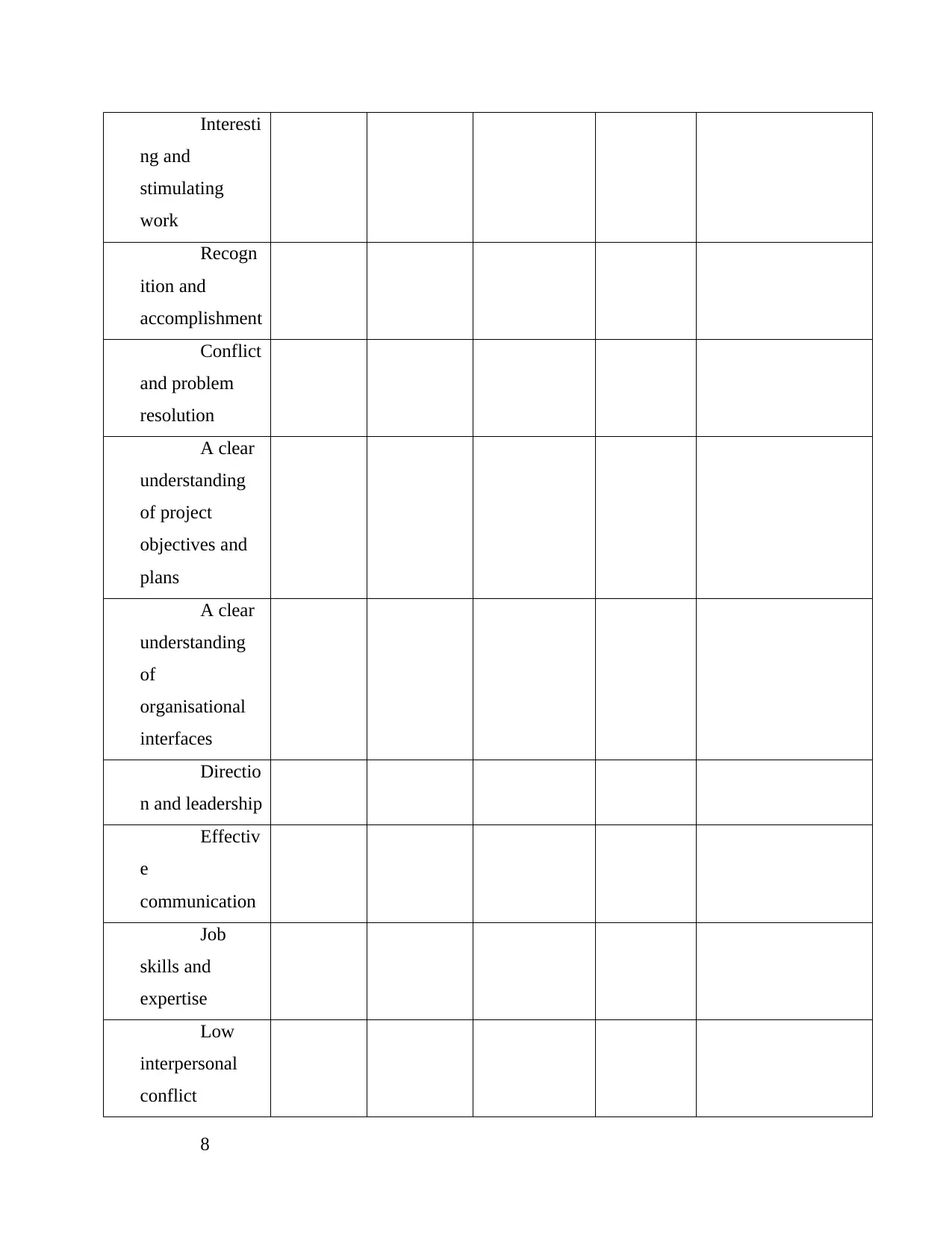
Interesti
ng and
stimulating
work
Recogn
ition and
accomplishment
Conflict
and problem
resolution
A clear
understanding
of project
objectives and
plans
A clear
understanding
of
organisational
interfaces
Directio
n and leadership
Effectiv
e
communication
Job
skills and
expertise
Low
interpersonal
conflict
8
ng and
stimulating
work
Recogn
ition and
accomplishment
Conflict
and problem
resolution
A clear
understanding
of project
objectives and
plans
A clear
understanding
of
organisational
interfaces
Directio
n and leadership
Effectiv
e
communication
Job
skills and
expertise
Low
interpersonal
conflict
8
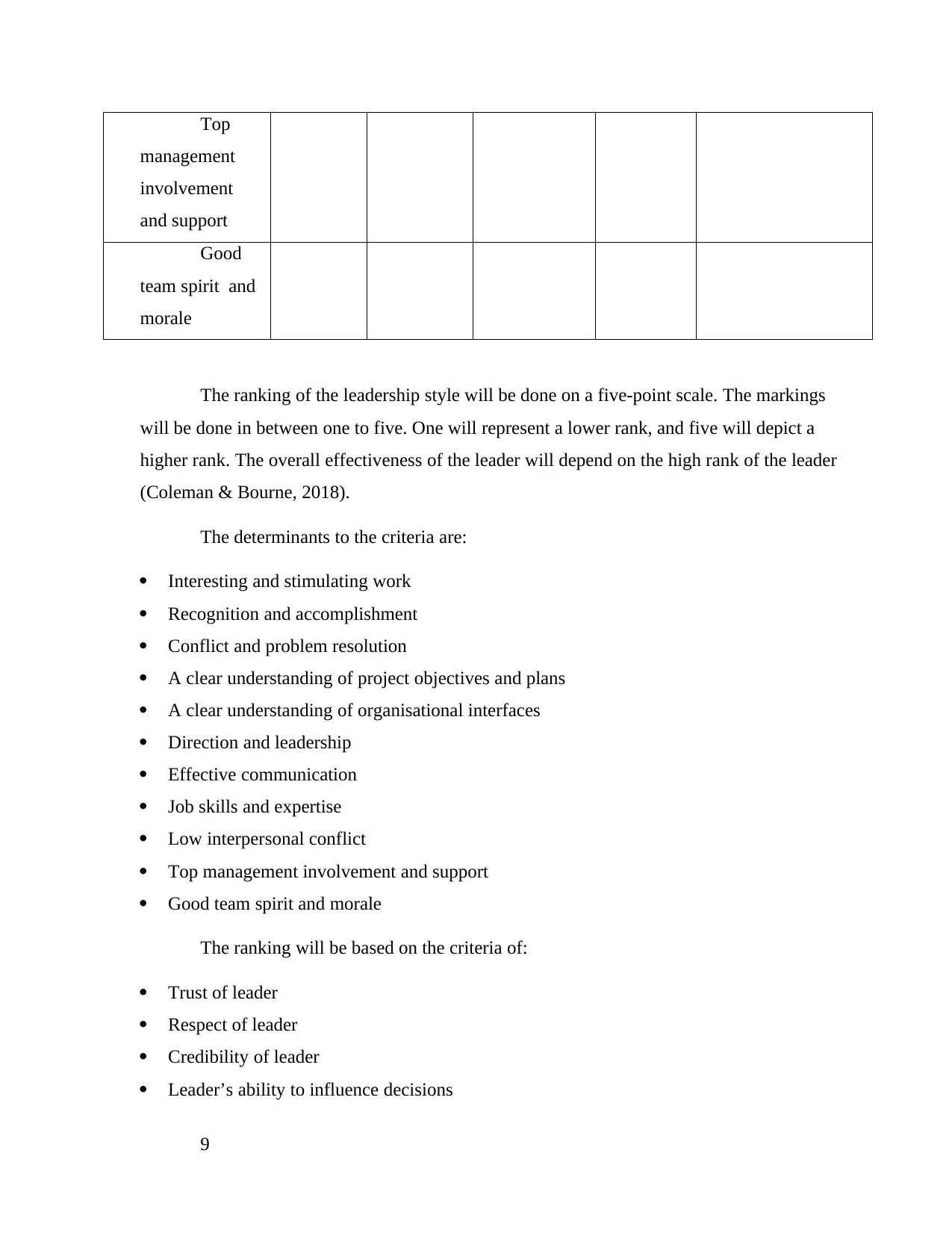
Top
management
involvement
and support
Good
team spirit and
morale
The ranking of the leadership style will be done on a five-point scale. The markings
will be done in between one to five. One will represent a lower rank, and five will depict a
higher rank. The overall effectiveness of the leader will depend on the high rank of the leader
(Coleman & Bourne, 2018).
The determinants to the criteria are:
Interesting and stimulating work
Recognition and accomplishment
Conflict and problem resolution
A clear understanding of project objectives and plans
A clear understanding of organisational interfaces
Direction and leadership
Effective communication
Job skills and expertise
Low interpersonal conflict
Top management involvement and support
Good team spirit and morale
The ranking will be based on the criteria of:
Trust of leader
Respect of leader
Credibility of leader
Leader’s ability to influence decisions
9
management
involvement
and support
Good
team spirit and
morale
The ranking of the leadership style will be done on a five-point scale. The markings
will be done in between one to five. One will represent a lower rank, and five will depict a
higher rank. The overall effectiveness of the leader will depend on the high rank of the leader
(Coleman & Bourne, 2018).
The determinants to the criteria are:
Interesting and stimulating work
Recognition and accomplishment
Conflict and problem resolution
A clear understanding of project objectives and plans
A clear understanding of organisational interfaces
Direction and leadership
Effective communication
Job skills and expertise
Low interpersonal conflict
Top management involvement and support
Good team spirit and morale
The ranking will be based on the criteria of:
Trust of leader
Respect of leader
Credibility of leader
Leader’s ability to influence decisions
9
⊘ This is a preview!⊘
Do you want full access?
Subscribe today to unlock all pages.

Trusted by 1+ million students worldwide
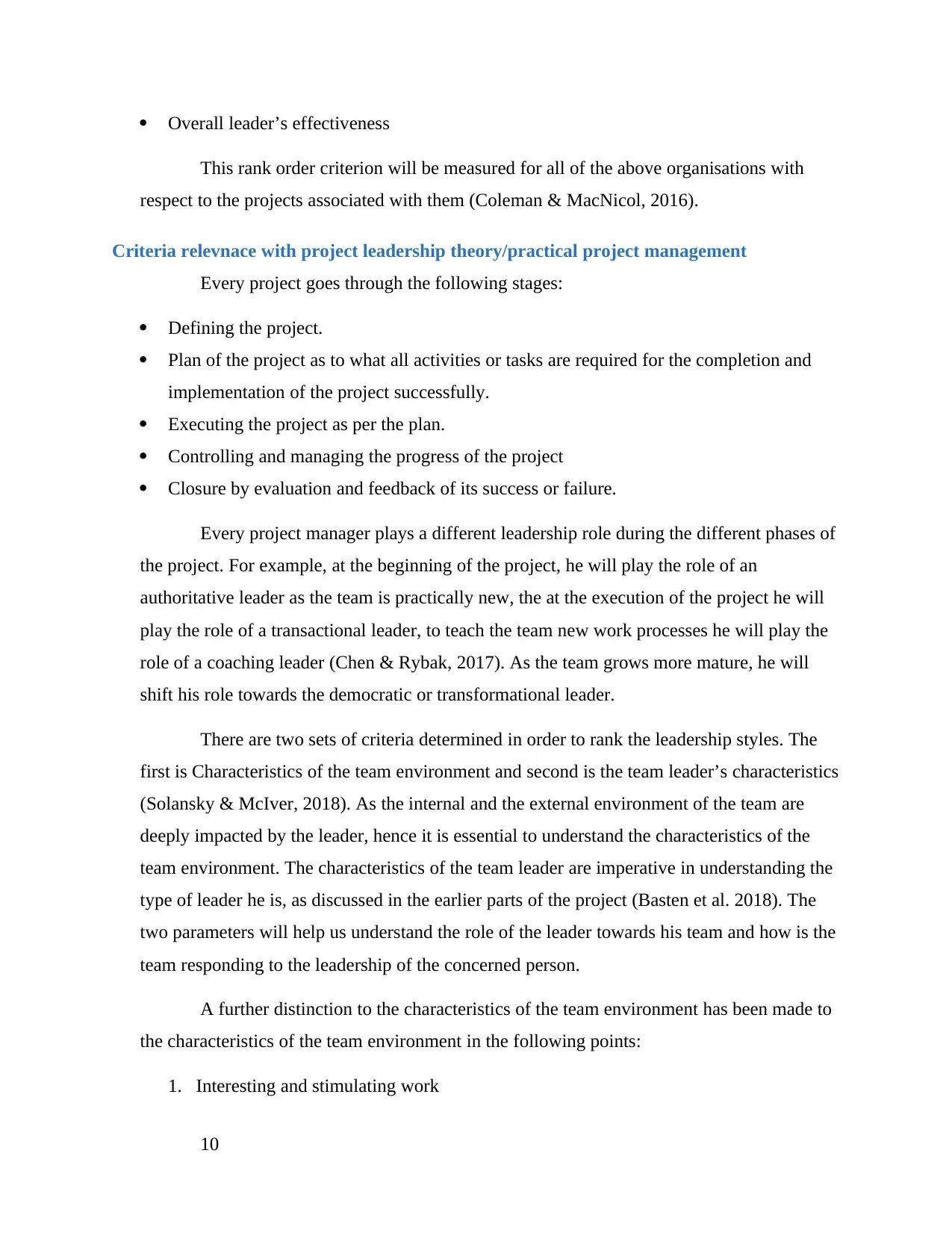
Overall leader’s effectiveness
This rank order criterion will be measured for all of the above organisations with
respect to the projects associated with them (Coleman & MacNicol, 2016).
Criteria relevnace with project leadership theory/practical project management
Every project goes through the following stages:
Defining the project.
Plan of the project as to what all activities or tasks are required for the completion and
implementation of the project successfully.
Executing the project as per the plan.
Controlling and managing the progress of the project
Closure by evaluation and feedback of its success or failure.
Every project manager plays a different leadership role during the different phases of
the project. For example, at the beginning of the project, he will play the role of an
authoritative leader as the team is practically new, the at the execution of the project he will
play the role of a transactional leader, to teach the team new work processes he will play the
role of a coaching leader (Chen & Rybak, 2017). As the team grows more mature, he will
shift his role towards the democratic or transformational leader.
There are two sets of criteria determined in order to rank the leadership styles. The
first is Characteristics of the team environment and second is the team leader’s characteristics
(Solansky & McIver, 2018). As the internal and the external environment of the team are
deeply impacted by the leader, hence it is essential to understand the characteristics of the
team environment. The characteristics of the team leader are imperative in understanding the
type of leader he is, as discussed in the earlier parts of the project (Basten et al. 2018). The
two parameters will help us understand the role of the leader towards his team and how is the
team responding to the leadership of the concerned person.
A further distinction to the characteristics of the team environment has been made to
the characteristics of the team environment in the following points:
1. Interesting and stimulating work
10
This rank order criterion will be measured for all of the above organisations with
respect to the projects associated with them (Coleman & MacNicol, 2016).
Criteria relevnace with project leadership theory/practical project management
Every project goes through the following stages:
Defining the project.
Plan of the project as to what all activities or tasks are required for the completion and
implementation of the project successfully.
Executing the project as per the plan.
Controlling and managing the progress of the project
Closure by evaluation and feedback of its success or failure.
Every project manager plays a different leadership role during the different phases of
the project. For example, at the beginning of the project, he will play the role of an
authoritative leader as the team is practically new, the at the execution of the project he will
play the role of a transactional leader, to teach the team new work processes he will play the
role of a coaching leader (Chen & Rybak, 2017). As the team grows more mature, he will
shift his role towards the democratic or transformational leader.
There are two sets of criteria determined in order to rank the leadership styles. The
first is Characteristics of the team environment and second is the team leader’s characteristics
(Solansky & McIver, 2018). As the internal and the external environment of the team are
deeply impacted by the leader, hence it is essential to understand the characteristics of the
team environment. The characteristics of the team leader are imperative in understanding the
type of leader he is, as discussed in the earlier parts of the project (Basten et al. 2018). The
two parameters will help us understand the role of the leader towards his team and how is the
team responding to the leadership of the concerned person.
A further distinction to the characteristics of the team environment has been made to
the characteristics of the team environment in the following points:
1. Interesting and stimulating work
10
Paraphrase This Document
Need a fresh take? Get an instant paraphrase of this document with our AI Paraphraser
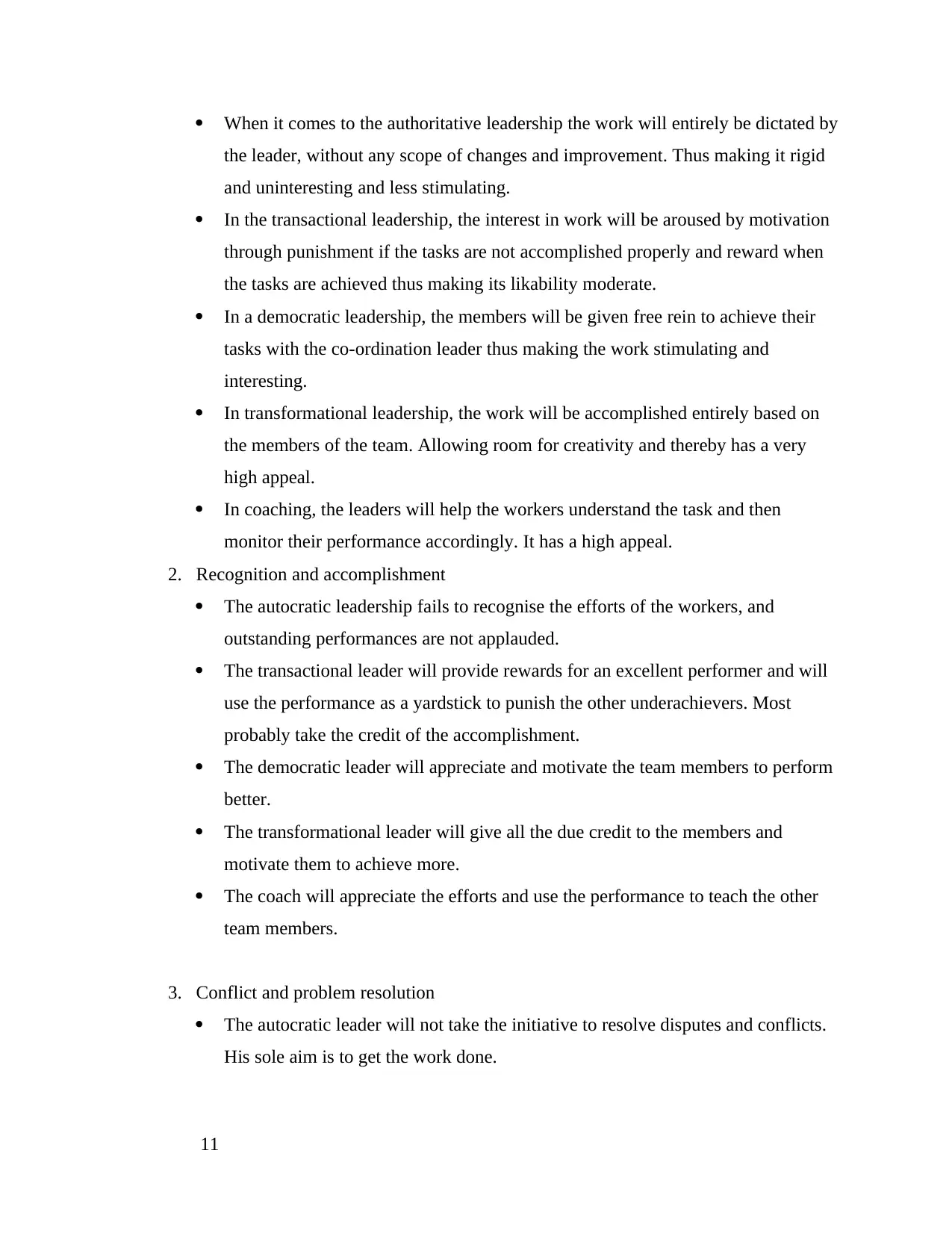
When it comes to the authoritative leadership the work will entirely be dictated by
the leader, without any scope of changes and improvement. Thus making it rigid
and uninteresting and less stimulating.
In the transactional leadership, the interest in work will be aroused by motivation
through punishment if the tasks are not accomplished properly and reward when
the tasks are achieved thus making its likability moderate.
In a democratic leadership, the members will be given free rein to achieve their
tasks with the co-ordination leader thus making the work stimulating and
interesting.
In transformational leadership, the work will be accomplished entirely based on
the members of the team. Allowing room for creativity and thereby has a very
high appeal.
In coaching, the leaders will help the workers understand the task and then
monitor their performance accordingly. It has a high appeal.
2. Recognition and accomplishment
The autocratic leadership fails to recognise the efforts of the workers, and
outstanding performances are not applauded.
The transactional leader will provide rewards for an excellent performer and will
use the performance as a yardstick to punish the other underachievers. Most
probably take the credit of the accomplishment.
The democratic leader will appreciate and motivate the team members to perform
better.
The transformational leader will give all the due credit to the members and
motivate them to achieve more.
The coach will appreciate the efforts and use the performance to teach the other
team members.
3. Conflict and problem resolution
The autocratic leader will not take the initiative to resolve disputes and conflicts.
His sole aim is to get the work done.
11
the leader, without any scope of changes and improvement. Thus making it rigid
and uninteresting and less stimulating.
In the transactional leadership, the interest in work will be aroused by motivation
through punishment if the tasks are not accomplished properly and reward when
the tasks are achieved thus making its likability moderate.
In a democratic leadership, the members will be given free rein to achieve their
tasks with the co-ordination leader thus making the work stimulating and
interesting.
In transformational leadership, the work will be accomplished entirely based on
the members of the team. Allowing room for creativity and thereby has a very
high appeal.
In coaching, the leaders will help the workers understand the task and then
monitor their performance accordingly. It has a high appeal.
2. Recognition and accomplishment
The autocratic leadership fails to recognise the efforts of the workers, and
outstanding performances are not applauded.
The transactional leader will provide rewards for an excellent performer and will
use the performance as a yardstick to punish the other underachievers. Most
probably take the credit of the accomplishment.
The democratic leader will appreciate and motivate the team members to perform
better.
The transformational leader will give all the due credit to the members and
motivate them to achieve more.
The coach will appreciate the efforts and use the performance to teach the other
team members.
3. Conflict and problem resolution
The autocratic leader will not take the initiative to resolve disputes and conflicts.
His sole aim is to get the work done.
11
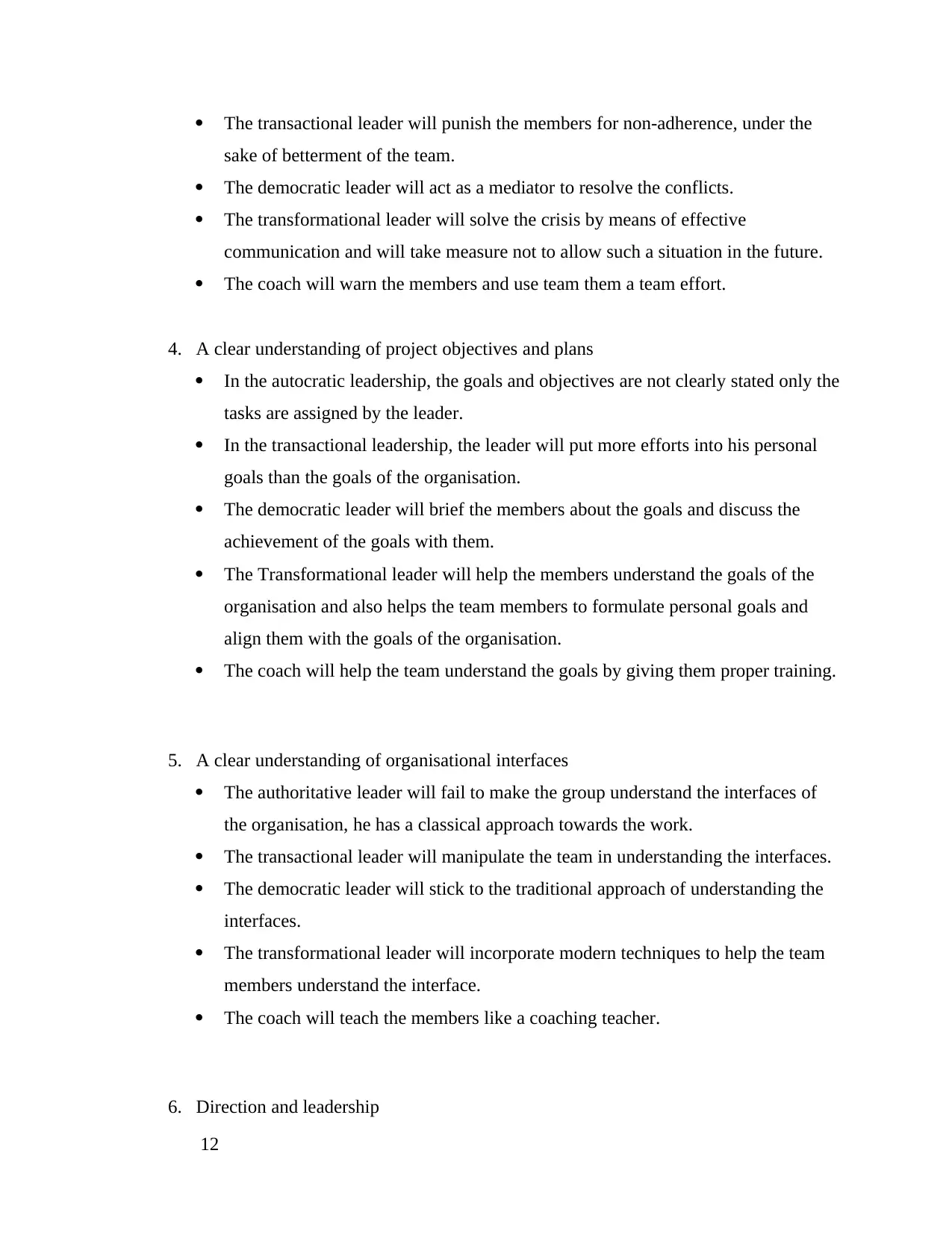
The transactional leader will punish the members for non-adherence, under the
sake of betterment of the team.
The democratic leader will act as a mediator to resolve the conflicts.
The transformational leader will solve the crisis by means of effective
communication and will take measure not to allow such a situation in the future.
The coach will warn the members and use team them a team effort.
4. A clear understanding of project objectives and plans
In the autocratic leadership, the goals and objectives are not clearly stated only the
tasks are assigned by the leader.
In the transactional leadership, the leader will put more efforts into his personal
goals than the goals of the organisation.
The democratic leader will brief the members about the goals and discuss the
achievement of the goals with them.
The Transformational leader will help the members understand the goals of the
organisation and also helps the team members to formulate personal goals and
align them with the goals of the organisation.
The coach will help the team understand the goals by giving them proper training.
5. A clear understanding of organisational interfaces
The authoritative leader will fail to make the group understand the interfaces of
the organisation, he has a classical approach towards the work.
The transactional leader will manipulate the team in understanding the interfaces.
The democratic leader will stick to the traditional approach of understanding the
interfaces.
The transformational leader will incorporate modern techniques to help the team
members understand the interface.
The coach will teach the members like a coaching teacher.
6. Direction and leadership
12
sake of betterment of the team.
The democratic leader will act as a mediator to resolve the conflicts.
The transformational leader will solve the crisis by means of effective
communication and will take measure not to allow such a situation in the future.
The coach will warn the members and use team them a team effort.
4. A clear understanding of project objectives and plans
In the autocratic leadership, the goals and objectives are not clearly stated only the
tasks are assigned by the leader.
In the transactional leadership, the leader will put more efforts into his personal
goals than the goals of the organisation.
The democratic leader will brief the members about the goals and discuss the
achievement of the goals with them.
The Transformational leader will help the members understand the goals of the
organisation and also helps the team members to formulate personal goals and
align them with the goals of the organisation.
The coach will help the team understand the goals by giving them proper training.
5. A clear understanding of organisational interfaces
The authoritative leader will fail to make the group understand the interfaces of
the organisation, he has a classical approach towards the work.
The transactional leader will manipulate the team in understanding the interfaces.
The democratic leader will stick to the traditional approach of understanding the
interfaces.
The transformational leader will incorporate modern techniques to help the team
members understand the interface.
The coach will teach the members like a coaching teacher.
6. Direction and leadership
12
⊘ This is a preview!⊘
Do you want full access?
Subscribe today to unlock all pages.

Trusted by 1+ million students worldwide
1 out of 25
Related Documents
Your All-in-One AI-Powered Toolkit for Academic Success.
+13062052269
info@desklib.com
Available 24*7 on WhatsApp / Email
![[object Object]](/_next/static/media/star-bottom.7253800d.svg)
Unlock your academic potential
Copyright © 2020–2025 A2Z Services. All Rights Reserved. Developed and managed by ZUCOL.




